
Spring is a census-designated place (CDP) within the extraterritorial jurisdiction of Houston in Harris County, Texas, United States, part of the Houston–The Woodlands–Sugar Land metropolitan area. The population was 54,298 at the 2010 census. While the name "Spring" is popularly applied to a large area of northern Harris County and a smaller area of southern Montgomery County, the original town of Spring, now known as Old Town Spring, is located at the intersection of Spring-Cypress and Hardy roads and encompasses a relatively small area of perhaps 1 square kilometre (0.39 sq mi).
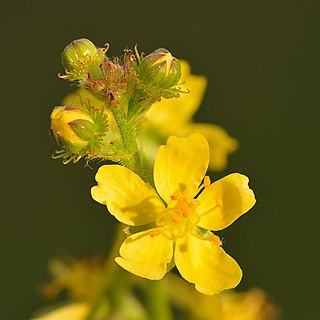
Agrimonia, commonly known as agrimony, is a genus of 12–15 species of perennial herbaceous flowering plants in the family Rosaceae, native to the temperate regions of the Northern Hemisphere, with one species also in Africa. The species grow to between .5–2 m (1.6–6.6 ft) tall, with interrupted pinnate leaves, and tiny yellow flowers borne on a single spike.

Channa striata, the striped snakehead, is a species of snakehead fish. It is also known as the common snakehead, chevron snakehead, or snakehead murrel and generally referred simply as mudfish. It is native to South and Southeast Asia, and has been introduced to some Pacific Islands. Reports from Madagascar and Hawaii are misidentifications of C. maculata.

The Shawangunk Grasslands National Wildlife Refuge is a wildlife refuge located in Ulster County, New York, United States. Formerly the Galeville Military Airport, it was decommissioned in 1994 and turned over to the United States Fish and Wildlife Service in 1999. It serves as a waypoint for grassland-dependent migratory birds.
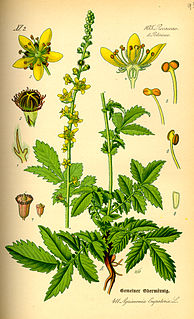
Agrimonia eupatoria is a species of agrimony that is often referred to as common agrimony, church steeples or sticklewort.

Melampyrum pratense, the common cow-wheat, is a plant species in the family Orobanchaceae.

Grevillea striata, also known as beefwood, is a tree or shrub native to all Australian states, with the exception of Victoria and Tasmania. Alternative common names for this species include western beefwood, beef oak, beef silky oak and silvery honeysuckle.

Peronospora is a genus of oomycetes that are obligate plant pathogens of many eudicots. Most species in this group produce a downy mildew disease, which can cause severe damage to many different cultivated crops, as well as wild and ornamental plants. There are 19 genera that produce downy mildew, and Peronospora has been placed alongside Pseudoperonospora in the group of downy mildews with coloured conidia. Peronospora has far more species than any other genus of the downy mildews. However, many species have been moved from this genus to be reclassified to other or new genera. Among these was the most famous Peronospora species, formerly known as Peronospora parasitica, and now known as Hyaloperonospora parasitica. Now, the Peronospora species of most importance is likely the Peronospora tabacina. Peronospora tabacina causes blue mold on tobacco plants and can severely reduce yields of this economically important crop to the point where it has been classified as a bioweapon.
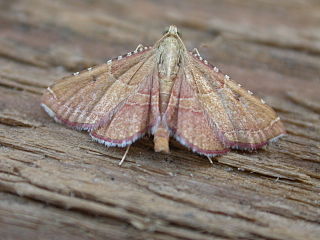
Endotricha flammealis, the rose-flounced tabby, is a species of snout moth, family Pyralidae.

Agrimonia parviflora is a species of perennial herbaceous flowering plants. Small-flowered agrimony, harvestlice agrimony, swamp agrimony, and harvestlice are its most common names in the United States.

Agrimonia gryposepala is a small perennial flowering plant of the rose family (Rosaceae), which is native to North America. This plant was used by various indigenous peoples to treat medical problems such as diarrhea and fever.

Gull Rock National Park is a small national park situated 25 km (16 mi) southeast of Albany in Western Australia. It was established in 2006, becoming Western Australia's 97th national park in the process. It is around 2,593 hectares in area.
Common agrimony is a common name for several plants and may refer to:
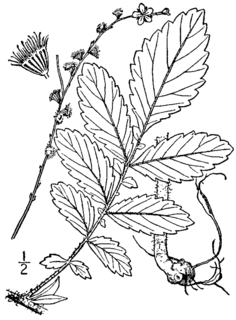
Agrimonia pubescens, the soft agrimony or downy agrimony, is a flowering plant in the genus Agrimonia, a member of the rose family. It grows in dry areas and woodlands.
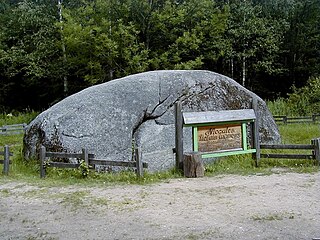
Nīcgale forest is Latvia protected landscape area in the north of Daugavpils Municipality, in Nīcgale Parish, east of Nīcgale. At the eastern point of the territory is Nicgale Great Stone.

Istra rolling hills is nature park in Istra Parish, Ludza Municipality, Latgale, Latvia. The landscape protection area Istra rolling hills is located between Lake Šķaune and Lake Maroksna in Latgale upland and Rāznava hills.















